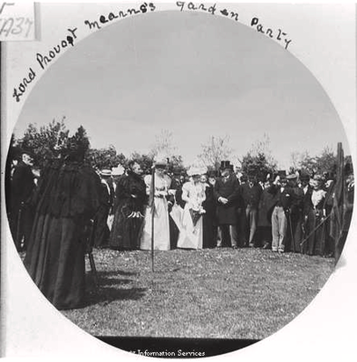JESSIE MEARNS BUYERS (1824-1916)
 Jessie Mearns Buyers may well be in this photograph.
Jessie Mearns Buyers may well be in this photograph.
Jessie Mearns Buyers was a ship’s chandler at Regent Quay in Aberdeen from her marriage in 1848 until her death in 1916. Whilst a nominally an unusual occupation for a woman, it is consistent with women working in family businesses and succeeding on husbands’ deaths.
She was born in 1824 to Daniel Mearns, a shipmaster, and his wife Helen Adam with the given name Janet, though she was always known as Jessie. In 1841 the family was living at 2 Yeats’ terrace, off Canal Street and withing a short walking distance of Regent’s Quay, being built at the time. In 1848, she married Peter Buyers, a grocer and spirit dealer based on Regent Quay. Connections between her father, a shipmaster, and Buyers, a ships’ chandler, attest to the endogamous connections that fostered marriage in business communities. They had seven children by 1861. They lost two sons at sea, while another became Consul to Denmark. Peter died in 1864, leaving her with children ranging in ages from 17 to 4. Her birth family was also large, and her younger brother Daniel Mearns worked in the firm of Peter Buyers. He became prominent in Aberdeen, was active in promoting many improvement schemes joining the Council in 1876 and serving as Provost, 1895–1898; he also was a member of the Fisheries Board and Consul to Argentina, in a very active public life.
Jessie’s role in the chandlery firm is obscured by the nominal labelling of family firms as ‘his’ enterprise, yet a substantial body of recent research shows that it was common for women to contribute to business, often as ‘silent’ partners, and that they did so despite the image of women retreating into domesticity. Thus, in October 1864, the Aberdeen Journal recorded that Jessie had applied for renewal of the firm ‘under the name or Firm Peter Buyers, 34 Regent Quay’. The Aberdeen Directory for the next year specified that Mrs. P. Buyers was a ‘ship chandler, etc., at 32 Regent Quay’, described in another section as grocer, ship chandler and spirit dealer; the home was at 31 Regent Quay. This overtly put her in charge, with probably two female servants and an apprentice (or young boy as a servant) in the household. By 1881, Daniel was sharing the house at 31 Regent Quay, having lived with his mother nearby until her death in 1875; he never married. His role in the business is also less clear. Although she is regularly referred to in the Directories and sometimes the newspapers, there are a couple of references suggesting it was also his firm. They may have been an effective partnership, but current information makes it impossible to tell.
She continued as ships’ chandler, living and working on Regent’s Quay, the main shipping harbour in Aberdeen regularly recorded in the Aberdeen Directory in her name (never Daniel’s). In 1880, however, we note a change as she retained the business on Regent Quay, moving to numbers 55 and 57, but also moving, with her brother, to 357 Great Western Road. She was now sixty-six, her brother was important in the town, and perhaps it was time to buy into a more genteel lifestyle. There is no evidence that she was less active, though the distance probably impacted or her day-to-day operation. In fact, the Directory entries suggest that the business was expanding operations and had done so for some time. In 1889 she was described as: ‘Buyers, Mrs Peter, wholesale ship chandler, oil, tallow, waste merchant and painter, 55 Regent quay and Commercial road, h 357 Great Western Road’. Newspapers also suggest a highly active and expanding business. She continued to expand adding glazier, tinsmith and coppersmith to her firm’s expertise. By 1900, the firm had also acquired a telephone; it is also the first time she was not specifically named. She was now seventy-six and it is highly likely that she remained the owner of the business but had stepped back from daily operations. Some newspaper entries suggest that her son Peter was working for the firm.
Her continued interest is indicated that when the company decided to become a joint-stock operation, in 1914, the newspaper reported: ‘Among the new joint stock companies registered in Scotland this week is P. Buyers, ship chandlers, etc. Regent Quay and Mearns Street, Aberdeen, The limited partner is Mrs Jessie Mearns or Buyers, 357 Great Western Road, Aberdeen.’ Setting up as a joint stock company was often a device to ensure the continuance of a firm and was increasingly used by nineteenth-century business families to transition from a single owner to a firm that could continue and compete in the more modern world of business. She was seventy-four, Daniel had died in 1913, Europe was on the brink of the first world war, and this made good business sense. In fact, she died in 1916, still as the chief stockholder. The firm continued but the sources do not indicate who was in charge after her death.
Entry written by Deborah Simonton.
She was born in 1824 to Daniel Mearns, a shipmaster, and his wife Helen Adam with the given name Janet, though she was always known as Jessie. In 1841 the family was living at 2 Yeats’ terrace, off Canal Street and withing a short walking distance of Regent’s Quay, being built at the time. In 1848, she married Peter Buyers, a grocer and spirit dealer based on Regent Quay. Connections between her father, a shipmaster, and Buyers, a ships’ chandler, attest to the endogamous connections that fostered marriage in business communities. They had seven children by 1861. They lost two sons at sea, while another became Consul to Denmark. Peter died in 1864, leaving her with children ranging in ages from 17 to 4. Her birth family was also large, and her younger brother Daniel Mearns worked in the firm of Peter Buyers. He became prominent in Aberdeen, was active in promoting many improvement schemes joining the Council in 1876 and serving as Provost, 1895–1898; he also was a member of the Fisheries Board and Consul to Argentina, in a very active public life.
Jessie’s role in the chandlery firm is obscured by the nominal labelling of family firms as ‘his’ enterprise, yet a substantial body of recent research shows that it was common for women to contribute to business, often as ‘silent’ partners, and that they did so despite the image of women retreating into domesticity. Thus, in October 1864, the Aberdeen Journal recorded that Jessie had applied for renewal of the firm ‘under the name or Firm Peter Buyers, 34 Regent Quay’. The Aberdeen Directory for the next year specified that Mrs. P. Buyers was a ‘ship chandler, etc., at 32 Regent Quay’, described in another section as grocer, ship chandler and spirit dealer; the home was at 31 Regent Quay. This overtly put her in charge, with probably two female servants and an apprentice (or young boy as a servant) in the household. By 1881, Daniel was sharing the house at 31 Regent Quay, having lived with his mother nearby until her death in 1875; he never married. His role in the business is also less clear. Although she is regularly referred to in the Directories and sometimes the newspapers, there are a couple of references suggesting it was also his firm. They may have been an effective partnership, but current information makes it impossible to tell.
She continued as ships’ chandler, living and working on Regent’s Quay, the main shipping harbour in Aberdeen regularly recorded in the Aberdeen Directory in her name (never Daniel’s). In 1880, however, we note a change as she retained the business on Regent Quay, moving to numbers 55 and 57, but also moving, with her brother, to 357 Great Western Road. She was now sixty-six, her brother was important in the town, and perhaps it was time to buy into a more genteel lifestyle. There is no evidence that she was less active, though the distance probably impacted or her day-to-day operation. In fact, the Directory entries suggest that the business was expanding operations and had done so for some time. In 1889 she was described as: ‘Buyers, Mrs Peter, wholesale ship chandler, oil, tallow, waste merchant and painter, 55 Regent quay and Commercial road, h 357 Great Western Road’. Newspapers also suggest a highly active and expanding business. She continued to expand adding glazier, tinsmith and coppersmith to her firm’s expertise. By 1900, the firm had also acquired a telephone; it is also the first time she was not specifically named. She was now seventy-six and it is highly likely that she remained the owner of the business but had stepped back from daily operations. Some newspaper entries suggest that her son Peter was working for the firm.
Her continued interest is indicated that when the company decided to become a joint-stock operation, in 1914, the newspaper reported: ‘Among the new joint stock companies registered in Scotland this week is P. Buyers, ship chandlers, etc. Regent Quay and Mearns Street, Aberdeen, The limited partner is Mrs Jessie Mearns or Buyers, 357 Great Western Road, Aberdeen.’ Setting up as a joint stock company was often a device to ensure the continuance of a firm and was increasingly used by nineteenth-century business families to transition from a single owner to a firm that could continue and compete in the more modern world of business. She was seventy-four, Daniel had died in 1913, Europe was on the brink of the first world war, and this made good business sense. In fact, she died in 1916, still as the chief stockholder. The firm continued but the sources do not indicate who was in charge after her death.
Entry written by Deborah Simonton.



